Industry-Sponsored Student Capstone Projects
2023/2024
In the 2023/24 academic year, the industry capstone program was supported by 54 sponsors, more than half of which were returning, and 95 real-world projects. Over five hundred fifty students from across the College of Engineering participated. Scroll down to learn more about each project.Hyster-Yale
Auto De-Gassing Device for Hydrogen Fuel Cell Cooling System
Hydrogen fuel cells are zero-emission engines that utilize hydrogen and oxygen to create electricity and water. The proton-exchange membrane (PEM) fuel cell stack is composed of repeating layers that are compressed together to create a desired power output. This creates separate sealed channels for hydrogen, air and coolant to flow into and across the stack layers. The cooling system with a fuel cell engine is critical to keep each stack layer at the desired temperature to control the stack water balance (how much water is created from the reaction) and prevent thermal damage to the stack layers. An automatic de-gassing device is a desirable in a fuel cell engine as it will prevent gas buildup within the cooling lines which can cause erratic and reduced cooling flow and damage the fuel cell stack. This student team will work to scope the project, limited to de-gassing device (or system) only, as follows: - The student team will work to utilize a device that shall provide a location for gas in the cooling system to be separated from the coolant and dispersed from the cooling system - The student team will work to utilize a device shall bleed gas without any input from operator or service technician - The student team will work to utilize a device that shall not leak coolant - This student team will work to utilize a device that shall not be made of materials that can leech ions to coolant - Depending on device location, this student team will work to utilize a device that shall be able to function with a cooling pressure between 0.9 (radiator cap release pressure) to 1.3 bar (cooling pump head pressure) - The student team will work to utilize a device that shall function with a coolant flow rate of 35LPM - The student team will work to utilize a device that shall be reasonably sized (think 12oz pop can as max size, but the smaller the better) - The student team will work to utilize a device that does not need to package within the existing B2D1 BBR covers, but should be adaptable to be used with the covers off - The student team will work to utilize a device that can have external hoses that connect to new or existing HYG components if needed This student team will work to achieve the following outcomes: • A patent search. This student team will work to identify existing designs/strategies for de-gassing that exist in industry and need to be part of existing background research • This student team will work to generate CAD models and drawings of prototype • This student team will work to design calculations that went into prototype or testing: -Coolant and gas flow calculations (for device) -Coolant and gas flow analysis (opportunity for CFD?) - Any student driven analysis • This student team will work to conduct the following testing: - Functional testing of device under nominal flow rate and pressure conditions. This will require the creation of a simplified cooling system bench test with the below elements: - Pressurized system (at coolant pressure per device location) - Flowing water at 35LPM flow rate - Ability to introduce known volume of helium into system (as substitute to hydrogen) • This student team will work to produce the following test outputs: - Confirm automatic de-gassing function - Establish if a specific volume of gas is needed before device engages - Confirm device does not leak during function
IDD Aerospace
Computer Vision Detection of Non-conformities
This student team will work to create a vision detection system built upon a stored learning model or neural network that detects defects in painted surfaces. IDD will provide parts and examples of known defects to aid in building the learning model. Once the system is developed, this student team will work to test it on trial runs within actual production to determine validity. This student team will work to design a system with good ergonomics; the design package this student team will work to create should fit and operate on a production desk. The student team will work to design a system that can interface with an isolated network and/or database environment to store and access learning model. The vision system must also be able to detect blemishes, fod, laser burns or defects at 0.5mm in size or greater, from a viewing distance of approx. 18 inches. Additionally, the student team will work to incorporate into the system's design the capability of measuring parts, or the ability to detect when hardware, like screws, are missing. The vision system this student team will work to create must employ some recognition system whether OCR or barcode detection to recognize job and part number. The outcome this student team will work to achieve is a system that provides a PASS / FAIL display, based on image recognition, and records the results. For questionable items, it would prompt the user on screen to review. The system should be scalable for when there comes a time in the future when Safran builds additional vision detection units, Safran would just have to link it to the software/database.
IDD Aerospace
Early Process Lighting Failure Detection via SDK Customization Script
During Safran's painting process, they globally apply a toning layer of paint to the parts, not knowing the specific locations of artwork aside from matching a transparent overlay sheet. They currently have the capability to take data readings at the finished process state. This student team will work to improve Safran's detection of premature failures by taking a reading of an unfinished part (without final legends being visible) and determine if the points that fall within those legend’s coordinates are passing or failing. Once the system is developed, this student team will test it on trial runs within actual production to determine validity. Safran utilizes Westboro Photometrica software which offers SDK and API capability. The software is currently setup to take readings; however, it requires the final legends to use as optical reference points. All of Safran's artwork is stored in dxf files that contain coordinate information. This student team will work to create a script/macro that takes a dxf as an input source, marries the reported data (from Photometrica) to the internal coordinates of the dxf letters, and by comparison of values, determines a pass/fail result for the entire panel.
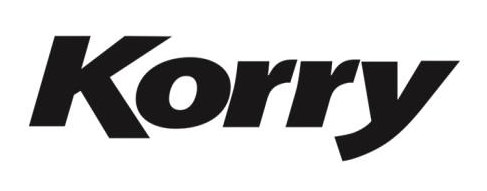
Korry Electronics
Emissive display technology in Aerospace applications
Organic emissive displays (OLEDs) have been on the market for a number of years and have been proven to have excellent optical characteristics but have other limitations that have prevented the advent of this technology into Aerospace applications. Technologists have developed in-organic emissive displays that are entering the commercial market space, although current manufacturing challenges have prevented full scale implementation. This student team will work to review the current manufacturing challenges to determine when size and resolution appropriate displays would be available for aerospace use. Further to this initial study, this student team will work to use currently available samples to produce a prototype use case that is representative of one of Korry's product families. Design parameters this student team will work to incorporate include integrating around an existing Korry product. This student team will work to consider compatibility with aerospace environmental requirements. Considering aircraft operating environments are already exposed to sound, vibration, and complex thermal exposure, this student team will also work to assess and integrate ruggedization and robustness. Ultimately, this student team will work to provide Korry with a better understanding of the manufacturing readiness level of current micro-LED production as it relates to Aerospace applications. This student team will also work to demonstrate to Korry their customers' future capabilities that will provide technological advancements in Korry's product families.
Latécoère
ARTIST: AircRaft cost and environmenTal efficIent door STructures
Passenger door structures are usually composed of beam and frame. This kind of structure is quite easy to manufacture in metal considering assembly of sheet metal and machined part or in composite through assembly of simple parts. This kind of structure is also quite difficult to optimize due to a wide stress field. A 3D lattice structure will present discrete load path easy to optimize. But this kind of structure is also quite difficult to put in place with classical technology. This student team worked to propose technology that would make it possible to manufacture a 3D lattice door that resulted in weight saving without cost impact. The surface of the door the students worked to produce was sized for emergency case and was provided by Latecoere. The thickness of door structure was constrained by the surrounding structure and was also provided by Latecoere. The student team did not work on interface as part of the scope but did work on a proposed hypothesis, and the pressure load case was considered. The sizing the student team worked toward took into account static strength with intact structure and damaged structure, as well as account fatigue. The density of the lattice was also part of the optimization. The student team worked to express the design performance by the weight achieved in regard to the target and also took into account the cost objective. The outcomes this student team worked to achieve include: -Candidate technologies and the selection report. - A design proposal. - A stress validation. - Coupon test evidence. - RC estimation - Weight evaluation -Risk assessment at the end of the project

Lockheed Martin
Digital Twins for New Materials Discovery
Traditional methods of material discovery and development are often time-consuming, costly, and rely heavily on trial-and-error approaches. Additionally, understanding the intricate relationships between a material's structure, properties, and performance at various scales remains a significant challenge. This student team will work to address a pressing need for a more efficient and precise approach to accelerate materials innovation. This student team will work to address the critical issue of expediting materials innovation through the implementation of digital twin technology. This student team will work to create virtual replicas of materials, encompassing both their physical attributes and functional behavior, and will aim to revolutionize the process of material discovery. This student team will work to conduct research that establishes the foundational frameworks and methodologies required to construct and continuously update digital twins, offering a promising avenue for enhancing the efficiency and effectiveness of new material development. This student team will work to create a framework that can be used to create digital twins of a wide range of materials, including metals, ceramics, polymers, and composites. The framework the student team is working to create can also be used to simulate the behavior of materials under a variety of conditions, such as during manufacturing, processing, and use. Students will work to create virtual replicas of materials, conduct tests, make virtual changes, etc. and to better understand the industry environment. Ultimately, this student team will work to create virtual replicas of materials, as well as process documentation of how to construct and continuously update digital twins, test data, lessons learned, and will work to provide next step recommendations.

Lockheed Martin
JetRacer Soccer with Advanced Sensor Suite
This student team will work to build upon the as-built hardware and software developments from the previous two years to demonstrate autonomous vehicles playing a game of soccer. The capabilities will be developed in phases, starting with the student team working with basic image recognition to strike a soccer ball using the RC car and visual imaging. Following that, the student team will work to develop advancements to the programming to drive the ball towards the net and score a goal in ideal conditions. Once goals can be scored, the student team will work to select and integrate additional sensors (optical, audio, or ranging sensors) to provide greater situational awareness in improve soccer playing capabilities. The final objective the student team will work towards is to have multiple RC cars play against each other and against a human. For this project, the student team will work to design, develop, deploy, and iteratively improve upon the autonomous vehicle which will: (1) Strike a defined ball in a controlled trajectory (2) Score a defined ball into a defined goal (3) Integrate additional sensors for greater situational awareness and abilities (4) Work collaboratively with teammate cars, or competitively against opponent cars to score goas (5) Stretch: integrate external referee sensors to determine when goals are scored, rules violated, etc. The deliverables of the project the student team will work to accomplish include: (1) An autonomous RC car with operational sensors and software (2) An open source sensor suite to assist in the autonomous playing of soccer (3) Control software experience and minor simulation software and data acquired through the project (4) Summary poster or powerpoint detailing the results, challenges, and lessons learned of the project (5) Video of the JetRacer playing soccer

Lockheed Martin
Lunar Electromotive Launch
This student team worked to develop a concept for lunar propellant electromagnetic launch system. The students worked to bring to life Lockheed Martin's vision of a nuclear-enabled water-based economy for cislunar space to literally fuel the path to Mars. The student team worked to create a liquid oxygen/liquid hydrogen chemical and liquid hydrogen nuclear thermal propulsion that both relied on lunar-sourced water; they also worked to harvest (and electrolyze and store) very high power level systems resources. This student team also worked to utilize the high-energy systems to drive electromotive systems (like a railgun) to launch the resources into orbit for subsequent collection. As a first objective, this student team worked to produce a conceptual design report for a lunar propellant electromagnetic launch system. The study included an assessment of where to crack/store water versus hydrogen versus oxygen (surface vs. orbit) and sized the electromotive launch system, specifically in regard to length and power needs. The students also worked to package resources for launch and worked to identify what the launched "thing" looked like. The student team also worked to get the package subsequently into a stable orbit (NRHO) for later retrieval. As a second objective, the students work to build and test a (very) subscale ground suborbital system of a lunar-applicable railgun, including launching payloads. The outcomes the student team worked to achieve include: 1: They worked to produce a conceptual design report for a lunar propellant electromagnetic launch system 2: They worked to build and test a (very) subscale ground suborbital system of a lunar-applicable railgun, including launching payloads
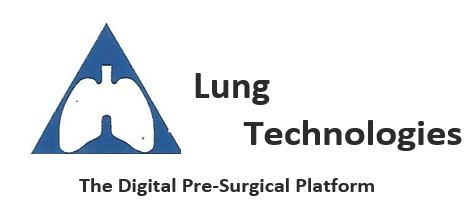
Lung Technologies
Lung Technologies - Deep Vein Thrombosis Prevention
Deep Vein Thrombosis or DVT's are a major post-surgical complication today in healthcare. Currently, there are only a few options to prevent and treat a DVT. Healthcare providers are admittedly over-prescribing blood thinners but will tell you they have very few options to prevent a pre- or post-surgical DVT. Lung Technologies is gearing up to change that with all new compression therapies and our novel and new C-Pam or 'Continuous Pressure > Active Motion" technology. This student team will work to create an 8 bladder sequential operating cuff wrapped around the patients calf to prevent blood stagnation, the cause of deep vein thrombosis (DVT's). The student team will work to create a bladder with an operating pressure of 80 & 120 mmHg. The student team will work to create a bladder that operates sequentially up and down the 3 calf muscle groups preventing blood stagnation, encouraging improved blood flow and thus preventing DVT's. The student team will also work to create a single enclosure housing the motor, air pump and power source attached to the cuff and bladders for ease of set up and ease of use by the nurse. The outcome this student team will work to achieve is a fully functioning prototype with the ability to take it to industry for licensing agreements. This student team will also work to provide all mechancial, electrical, and computer specifications to Lung Technologies with the ability to take the product to industry for manufacturing.

Lung Technologies
Lung Technologies - Incentive Spirometer
Pulmonary Atelectasis, fever and pneumonia are common and costly post-surgical complications today. Current treatments include an Incentive Spirometer given to the patient. The problem is that the patient does not use it as prescribed or does not use it correctly so their lung alveoli are not re-expanding after surgery causing pulmonary atelectasis. Today, there is no way to monitor a patient's Incentive Spirometer use. Lung Technologies is gearing up to change that with an all new digital user-interface on the Spirometer as well as a re-design of the Spirometer to add additional features asked for by respiratory therapists and pulmonologists. Current Incentive Spirometers have been around for 30 years and have not changed or improved at all. Covid-19 brought to light the importance of good and strong lung alveoli health. Covid-19 attacked the lung alveoli and an Incentive Spirometer was prescribed to patients with Covid-19 to improve their pulmonary function. This student team worked to not only bring an Incentive Spirometer up to modern standards, but to completely re-design the Incentive Spirometer with a fully functioning prototype to include a new and first of its kind digital user-interface. This student team also worked to add additional features that respiratory care wants, including aerosol attachment capabilities. This student team worked in Solidworks and through other engineering software to be able to take it to industry for manufacturing and licensing deals.
McKinstry
Electrical Capacity Management for Electric Fleets
EV infrastructure (i.e. charging) is very, very expensive and has seen limited (if any) improvement in cost efficiency as the market scales. A large portion of the cost comes from the electrical capacity requirements. McKinstry is facing electrical capacity constraints as they build EV charging infrastructure – both for their own electrifying fleet and at customer facilities. This student team will work to build a proof-of-concept simulation using emerging electrical controls technology to manage electrical load, while still meeting fleet operational requirements and National Electrical Code (NEC). The primary outcomes this student team will work to accomplish are: - Create simulations of charging requirements for several common use cases. This will define how load needs to be managed and curtailed by charging hardware/software. This also will involve modeling the load of the building and any connected energy systems. This could be by building a simulation from scratch or using commercial tools like: https://www.ampcontrol.io/simulation-tool - After defining how chargers need to operate, build a charging system that can dynamically manage charging/building load. This will likely leverage commercially available products. The outcomes this student team will work to accomplish include: − Simulation of EV charging and energy requirements −Demonstration that energy requirements can be managed by charging hardware/software, while meeting National Electrical Code (NEC) requirements.

Micron
Systematic Variation of Transistor Characteristics from High Volume Wafer Fabrication
This student team worked to leverage their engineering and data science skill sets to tackle a real world manufacturing data set. The initial stage of the project focused on data engineering, analysis, and method building. Upon assessment of data correlations, this student team worked to narrow scope and dig deeper into a portion of semiconductor fabrication process to identify root cause. DRAM CMOS devices exhibit systematic variation in threshold voltage resulting from the hundreds of process steps used to fabricate them. Micron suspected that some process variation [tool-to-tool, wafer-to-wafer] was directly correlated. This student team worked to identify the process steps, whose variability had the greatest influence on wafer level median NFET and PFET Vt. Under this problem statement, this student team worked to identify influential process steps and attempted to build a physical root cause assessment. Additional data or process details were provided on a need base as the project progressed. This project presented students with the opportunity to utilize their engineering and data science training on a real world problem set. The student team also had the opportunity to network with Micron, with the intent of helping students to explore careers in the growing area of domestic semiconductor manufacturing and R&D.

Microsoft
Large-Scale Algorithm Development
This student team worked to develop a large-scale algorithm in Q#. For this project, Microsoft took a state-of-the-art algorithm description from the literature (for example, in the field of quantum chemistry or quantum cryptanalysis). This student team worked to create a development specification which broke down the algorithm into sub components and helped to organize the project structure. For each component optimized or trade-off implementations were discussed, for example, different arithmetic building blocks. The student team also worked to contain a test plan in the development specification that described how the correctness of the operations can be guaranteed using the help of quantum simulators. This student team worked to analyze the overall algorithm using the Azure Quantum Resource Estimator to derive conclusions on the practical applicability of the algorithm in the presence of fault-tolerant quantum computers. The desired outcome this student team worked to achieve was a complete Q# implementation of the algorithm to be shared as an open source project with the quantum computing community. In addition, the student team worked to create a scientific report to shed light into interesting implementation decisions (based on the development specification) and the results of the resource estimation analysis.

NASA Jet Propulsion Laboratory
Data Science for Scientific Discovery: Machine learning to evaluate the risk and resilience of societal critical infrastructure to space weather
This student team will work to explore the characteristics of space weather impacts on critical infrastructure, specifically the power grid and communications systems. This student team will work to utilize a machine learning model to predict outcomes in various cases and identify non-obvious connections. This student team will work to integrate data from the solar wind, geospace environment, and the critical infrastructure to study the systems effects. This student team will work to apply extreme value analysis (estimate of 1/100 year conditions), network analyses (understand the connectivity of the critical infrastructure), and machine learning (predictive capabilities). The outcome this student team will work to accomplish is to create a framework for studying risk and resiliency of a space weather natural hazard on a certain critical infrastructure. The student team will work to accomplish this outcome via the following programmatic milestones and processes: - Create analysis ready datasets - Development plan/approach -Extreme value analysis 1/100 year estimates -Network Analyses initial results -Machine learning initial results -A report out and conference/workshop presentations
Novo Nordisk
Sickle Cell Disease Patient-Provider Match Tool
As a sickle cell disease patient (SCD), finding the right provider can sometimes be an extremely difficult challenge. Complicating factors such as cultural differences, medical biases, lack of disease knowledge, proximity to a care center, financial hardship, can all lead to a situation of suboptimal care. To help mitigate these factors, this student team will work to design and develop an application that recommends and matches SCD patients to high-value SCD providers – providers who have demonstrated a robust knowledge of the disease state and have a standout record of treating this disease. This would be a readily available smartphone application which would have the capability to understand the exact clinical and behavioral situation of the patient, and then recommend the patient to a provider or hospital which has scored on quality measures to match to the patient specific needs. Some of the key objectives this student team will work to evaluate when designing the SCD tool include: • Data models focused on SCD treatment • Analysis of national, regional, and/or local hospitals and payers to determine the care data associated with treating SCD • The data model ideally would be capable of scraping and ingesting treatment data from hospitals, providers (and payers?) to empower patients to understand the differences in receiving care. • Care descriptions/details should be reflected as a care score based on quality features of the provider/hospital as well as economic factors, location, disease state experience. The outcomes this student team will work to achieve are: • A working prototype, end-user platform. • A solution that is accessible from desktop, tablet, smartphone • A name and/or branding for tool • Optimized user-centric (patient) designs and workflow (UX)
Related News
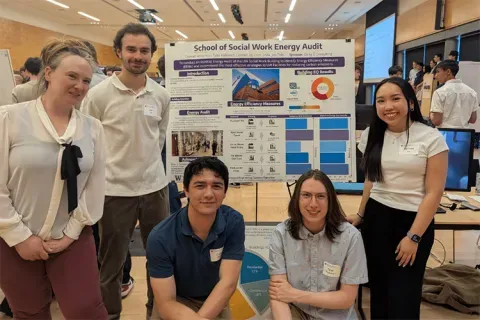
Mon, 10/13/2025 | UW Mechanical Engineering
Capstone collaboration leads to award
An ME capstone team received first place for its energy audit of the UW School of Social Work building.
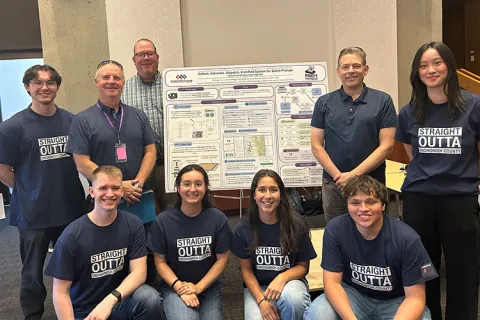
Thu, 07/17/2025
UW engineering students develop smart ballot solution
UW engineering students develop smart technology solution to improve ballot collection for Snohomish County.
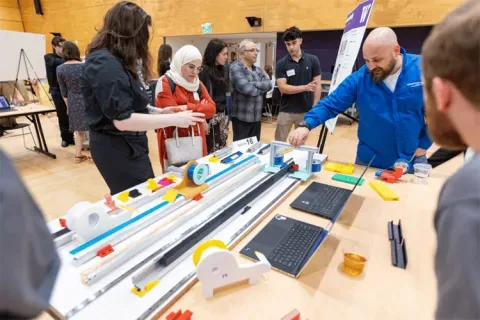
Mon, 07/07/2025 | UW Mechanical Engineering
Capstone creations
Students displayed innovative capstone design projects at the 2025 expo.

Fri, 09/20/2024 | UW Civil & Environmental Engineering
Smarter irrigation for a greener UW
A new project combines satellite data with ground sensors to conserve water and create a more sustainable campus environment.